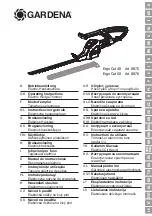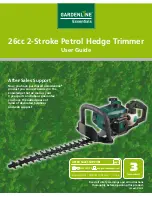
16
1045 - 001 -
01.06.2020
Idling speed adjustment procedure
The engine is adjusted at factory shipment. If the engine
stops or the engine speed is too high due to the change
of the operating conditions (running in the engine, high
altitude operation, etc.), or if the engine stops when the
throttle lever is set to the idling position, adjust the idle
adjustment screw following the procedure below.
If the problem persists even after adjustment, consult
your dealer for possible causes.
1. Clean the air filter and attach the air filter cover.
2. Start the machine. Refer to
3. Turn the idle adjustment screw (T) clockwise until
the blades start moving.
4. Turn the idle adjustment screw counterclockwise
until the blades stop.
WARNING: If the blades do not stop
when adjusting the idling speed, contact
your dealer. Do not use the machine
until the adjustment or repair is
completed.
5. Adjust the idling speed to 3000 rpm.
Note: If the idling speed is appropriate, the engine will
run smoothly in any position. For recommended idling
Inspection of the spark plug
CAUTION: Be sure to use the specified
spark plug.
(Refer to
Using an unspecified product may damage
the cylinder or piston.
The spark plug will be deteriorated by the following
causes.
● Improper carburetor settings
● Incorrect fuel mix
(Excessive or inappropriate type of oil)
● Air filter contamination
If carbon adheres to the spark plug electrode due to the
above reasons, it may cause problems during operation
or difficult starting. Check the spark plug if the engine
does not have enough power, does not start smoothly,
or if idling is unstable. If the spark plug electrode is dirty,
clean it. Confirm that the electrode gap is 0.6 to 0.7 mm.
Replace the spark plug when it has been used for a
month. If necessary, replace the spark plug.
Engine cooling parts cleaning
procedure
CAUTION: If the cooling air intake and
cylinder fins are dirty or clogged, the
machine will become hot and may be
damaged.
● The machine is equipped with cooling air intakes and
cylinder fins to keep the operating temperature as
low as possible.
● Confirm that the cooling air intake and cylinder fins
are free from dirt and clogging.
● Clean the cooling air intake and cylinder fins once a
week with a brush, more frequently in harsh
operating environments. If the cooling air intake and
cylinder fins are dirty or clogged, the machine will
overheat, causing damage to the piston and cylinder.
















































